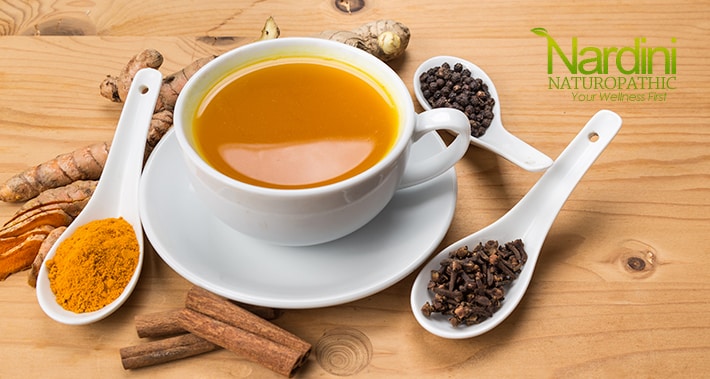Turmeric and curcumin are often confused for the same thing; turmeric is the root, and curcumin is the active ingredient within it.
Turmeric is a spice with a vibrant yellow hue. It’s often called “Indian Saffron” for that reason.
Turmeric is well known for its natural pain relief properties, and has been used in Ayurvedic and naturopathic medicine.
In India, it is frequently used to treat not just ‘aches and pains’, but for digestive issues and skin conditions.
What Is Curcumin And Turmeric?
Turmeric, as mentioned above, is a root – it looks slightly like ginger root, though not as chunky, and far more deeply golden.
In fact, as the root of the Curcuma longa plant, it comes from the same family as that of ginger.
It is very popular in Asian cuisine and is one of the main ingredients in curries.
Turmeric is host to a variety of plant substances, but the curcuminoids are the ones that have the most noted effect on health.
Of the curcuminoids, curcumin is the most active, but others include desmethoxycurcumin and bisdemethoxycurcumin.
Curcumin has anti-inflammatory, antioxidant, and anti-tumour properties.
Below we list benefits for both turmeric and curcumin; for most of the benefits, it applies to BOTH of them, although in different instances one form will work better than the other.
For example, both curcumin and turmeric are antifungals, but curcumin is just one of 8 antifungal substances within turmeric, so it works better when they’re taken together.
More on that in a minute.
Increasing Bioavailability
It’s one thing to ingest turmeric.
Getting your body to absorb it is a whole other matter; this process is called bioavailability.
The more bioavailable, the more effective these ingredients are.
There are several ways of increasing the bioavailability of the curcumin found in turmeric.
Black pepper’s active ingredient piperine can help the process, as can consuming turmeric with a source of fat such as nuts, nut butters, fish, and avocados.
These allow the curcumin to be absorbed more efficiently. This is why you can sometimes find curcumin capsules that include black pepper.
Benefits Of Turmeric
Now, let’s get you up to speed on the benefits of Turmeric.
Strong Antifungal
Turmeric is a bit of a power ranger when it comes to being an antifungal.
Turmeric has eight compounds that inhibit fungal cell growth1.
The most potent of these is curdione.
Interestingly, it’s even more powerful when combined with the other seven compounds than when it’s all on its own.
Suppresses Tumour Growth
Cancer is a disease caused by uncontrolled cell growth within the body.
Both turmeric and curcumin – but turmeric, especially – have been shown to affect the growth, development, and spread of cancer.
It is especially effective with colon cancer and colorectal cancer.
It can also be a big helper in killing cancerous cells and preventing metastasis and angiogenesis2.
Studies are working to determine if turmeric can help prevent cancer forming, at least for the cancers of the digestive system.
Benefits Of Curcumin
The good news is that when you take turmeric, you’re getting curcumin along for the ride.
Here are some of the benefits that are stronger for curcumin on its own than turmeric as a whole.
Increases Antioxidant Effectiveness
Curcumin’s chemical structure makes it a powerful antioxidant that is able to identify and neutralize free radicals in your body3.
As a bonus, it also supercharges your body’s OWN antioxidant enzymes, delivering a potent attack on the oxidative damage that causes many diseases and the aging process.
Managing Type 2 Diabetes
Although they both help, Curcumin is the better helper when it comes to diabetes4.
Curcumin affects the foundations of type 2 diabetes by lowering the inflammatory markers, tumor necrosis factor (TNF) and interleukin 6 (IL-6).
By reducing the blood sugars, people with high curcumin intake may be able to avoid or reverse type 2 diabetes.
Benefits They Both Share
Now we’ve seen how useful they can be on their own, let’s look at why turmeric and curcumin are such a dynamic duo.
Osteoarthritis
Osteoarthritis is an example of an inflammatory disease, which is definitely in the wheelhouse of curcumin and turmeric5.
Curcumin and other compounds reduce markers of inflammation, which brings relief to osteoarthritis symptoms.
Obesity
Additionally, there are a lot of inflammatory responses that contribute to obesity. Scientists have been working to discover how effective anti-inflammatory treatments could be.
As it turns out, turmeric and curcumin might be effective in inhibiting the inflammatory pathway, which would allow body fat to be better regulated6.
Heart Disease
Heart Disease is still one of the top causes of death in North America, which is why there’s so much research going into helping cardiovascular health with turmeric and curcumin.
They are both helpful in reducing LDL cholesterol and triglycerides, which are two major factors associated with heart disease.
Curcumin additionally helps by improving blood vessel endothelial function, possibly to the same effect as the well-known drug Atorvastatin.
To give context, in one small study of 121 patients, it decreased their risk of heart attack by 65%.
Diabetes
Turmeric and curcumin help reduce the effects experienced by diabetes because they have such a potent effect on stabilizing blood sugar levels and metabolism7.
Curcumin can decrease the level of glucose in the blood, and it may possibly help in diabetes prevention8.
Other Benefits
Continuing efforts are going into understanding the depth of the impact of turmeric and curcumin on brain diseases.
Curcumin has been noted for improved brain function, and both help with depression.
As well, a study has shown that both turmeric and curcumin can protect against chronic liver damage.
1. https://www.ncbi.nlm.nih.gov/pmc/articles/PMC5854386/
2. https://www.ncbi.nlm.nih.gov/pmc/articles/PMC3392043/
3. https://www.ncbi.nlm.nih.gov/pubmed/15650394
4. https://www.ncbi.nlm.nih.gov/pubmed/11855620
5. https://www.ncbi.nlm.nih.gov/pmc/articles/PMC5003001/
6. https://www.ncbi.nlm.nih.gov/pubmed/23339049/
7. https://www.ncbi.nlm.nih.gov/pmc/articles/PMC4393385/
8. https://www.ncbi.nlm.nih.gov/pubmed/20227862
Book An Appointment With Nardini Naturopathic
At Nardini Naturopathic, we’re happy to look at natural options to help treat your conditions.
Have you been concerned recently about one of the conditions above, or did you get a recent diagnosis that you are investigating?
Call now to set your appointment with Nardini Naturopathic, and we can discuss options, such as turmeric and curcumin, to get you back to whole health again.
If you have questions about naturopathic medicine, or you’d like to take your first step into the world of naturopathy, contact us at Nardini Naturopathic, and let’s book an appointment.
Yours in health,
Dr. Pat Nardini, Naturopathic Doctor
320 Danforth Ave suite 206,
Toronto, ON, M4K 1N8
-https://g.page/NardiniNaturopathicDanforth
Dr. Pat Nardini, ND is a licensed doctor of naturopathic medicine in Toronto, Ontario. He offers science based natural health solutions with a special focus on thyroid conditions.


